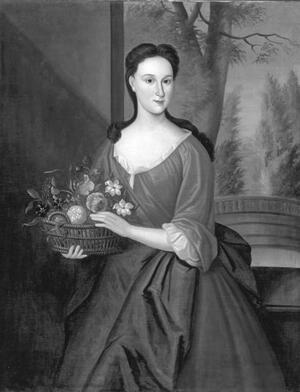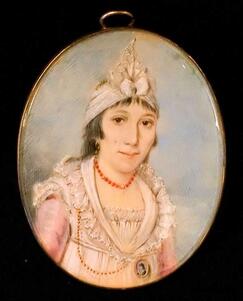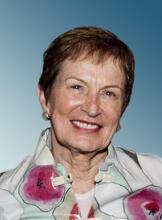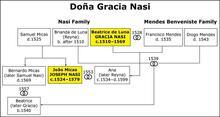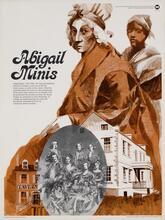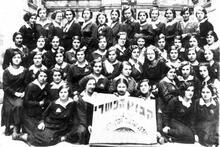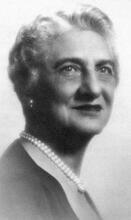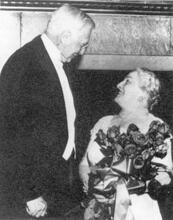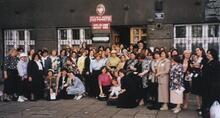Colonial Period in the United States
Jewish women in colonial America led varied lives, with some occupying traditional roles as mothers and wives and others remaining single. Jewish marriages were often still arranged, with small communities as well as economic pressures contributing to the popularity of arranged matches. Jewish households generally relied on women’s labor; some women ran their own businesses, while others worked as servants for Jews with more money. Some women received strong educations, with families of means engaging private tutors for daughters and some women perhaps attending schools maintained by the Jewish community, which taught secular as well as religious matters. Both in and out of the synagogue, women played a crucial role in early American Jewish communities.
Building the Jewish Community
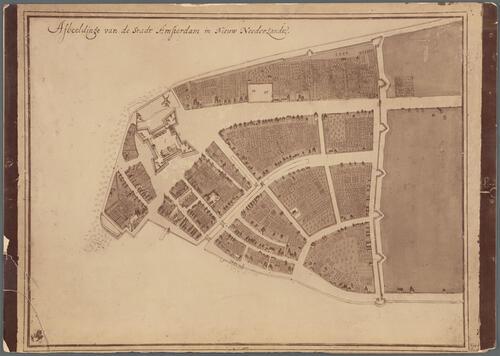
Detail of the Castello Plan 1660 map of New Amsterdam. Lot owned by Levys marked in white. Courtesy of New York Public Library, Digital Gallery. Digital ID: 54682, Digital Record ID: 118555. Annotated by Laura Arnold Leibman.
Records written by Jewish women in the colonial United States are sparser than for later eras. Moreover, the documents that do survive are disproportionately by wealthier women such Abigail Franks and Abigail Minis, who had the time and education to create written records. Most colonial Jewish women were quite poor, often depended on communal pensions to make ends meet, and did not have the same access to education as wealthier co-religionists did. Remaining evidence reveals Jewish women in colonial America led varied lives, with some occupying traditional roles as mothers and wives and others remaining single. Some ran their own businesses and others worked as servants for Jews with more money. Both in and out of the synagogue, women played a crucial role in early American Jewish communities.
Despite the lack of female-authored texts, we know women were essential to the construction of Jewish American congregations. Their arrival signaled a shift from isolated male travelers to the building of synagogues, schools, and ritual baths. Two of the first women to land in the colonies that later became the United States were Ricke Nunes and Judith Mercado, who arrived as refugees from Recife, Brazil in 1654. As Johannes Vingboons’ 1664 print demonstrates, New Amsterdam was hardly the booming Jewish center they had left behind. While many early refugees eventually sailed back to the Netherlands, those who stayed helped build the families that were central to the town’s fledgling Jewish community.
Another early arrival in the town that would become New York was Miriam Levy, who lived in one of the Dutch gabled houses between Hoogh Straet and Slyck Straet. The 1660 map shows a good-sized plot with a garden and a two-story house with an attic. Most likely the kitchen was in the cellar, with a front and back room on the first floor and bedrooms on the second floor. Like many Dutch Jewish families, the Levys loved art: nine paintings decorated their walls, perhaps biblical scenes like those popular among Jews in Amsterdam at the time. Miriam’s husband Asser Levy served as the community’s kosher butcher (shochet), and the large number of dishes they owned at his death suggests they had service for both milk and meat meals. We also know what Miriam Levy wore: a red petticoat and stockings, shoes, bodice, lace cap, and jewelry.
While men often only referred to women in communal records when females were born, married, or gave birth, Jewish households relied on women’s labor. For example, when Nathan Simson arrived in New York in the early 1700s, he stayed at a kosher boarding house run by his niece Meriam (Levy) Hart and her husband Moses Hart. While the money for Simson’s board went to husband Moses Hart, it was almost certainly Meriam who oversaw the changing of her uncle’s linens, the washing of his clothes, and the cooking of his meals. During the years when Simson was in New York, he served as president of the fledgling congregation Shearith Israel, but his day-to-day religious observances relied on women’s service. When Nathan Simson struck out and set up his own house, a servant named Ester and a cook named Risha tended to his needs and kept his Term used for ritually untainted food according to the laws of Kashrut (Jewish dietary laws).kosherkitchen. The women, in turn, relied on the assistance of the labor of an enslaved African boy Simson had purchased. As historian Jonathan Israel puts it, Jewish colonial women were both victims and agents of the empires that sent Jewish men seeking their fortune in the British colonies.
To Marry or Not?
Miniature of Sarah Moses Levy of Charleston (c. 1798). Notice how she wears her son’s miniature. Courtesy of College of Charleston Library.
Small communities as well as economic pressures contributed to the popularity of Jewish arranged matches. By the first half of the 1700s, Jewish women were living in several port towns in the United States colonies, including Newport, Philadelphia, Charleston, and Savannah, but the exceedingly small size of each community still necessitated choosing marriage partners not only from among the local population but also from among the Jewish communities located elsewhere in North America, in the Caribbean, England, Amsterdam, and Hamburg. Men—particularly merchants—also used marriages to create personal and mercantile networks that spanned the Atlantic world. Such networks bestowed commercial advantage on the Jewish merchants who resided in each location and comprised the upper ranks of each Jewish community.
Yet the few surviving letters from women reveal at least some colonial Jewish women felt a new desire to marry for love. For some women like Phila Franks, following one’s heart meant marrying a non-Jew. Others chose not to marry at all rather than spend their lives in a loveless match. Although intermarriage was on the rise, overall Jewish women entered into such marriages with Christians less frequently than Jewish men did. Moreover, some who married for economic gain fell into love later. After Nathan Simson died in London in 1725, one of Dyfie Simson’s friends from New York wrote hoping that “God give you [Dyfie] strength and comfort in your grief.” Apparently Dyfie Simson overcame her despair, as in 1727 she returned to the Netherlands and married widower Abraham de Vries.
Jewish participation in international commerce disrupted women’s lives. Women like Dyfie Simson who married men from other parts of the Atlantic world sometimes remained in their family’s home town, but they might just as likely move to their husbands’ communities, separated by great distances from their own parents, siblings, and friends. Moreover, merchant husbands traveled frequently and extensively, while sons were often posted to distant ports to act as commercial representatives for their families. For those with financial resources, miniature ivory portraits became an important way to keep far-away family members close, sometimes with a small snip of the loved one’s hair captured beneath the glass on the miniature’s back. Miniatures were also used to make matches in faraway ports.
Not all women, however, chose to marry, nor could all women afford to do so. In addition to the cost of the wedding itself, arranged marriages relied on dowries. Orphans sometimes applied to organizations such as the Santa Companhia de Dotar Orphas e Donzelas (Holy Brotherhood of the Endowment of Orphans and Maidens) run by the Portuguese Jews of Amsterdam, which ran a yearly lottery to provide dowries for those in need. In 1692, Rachel do Vale of “Nieuwjorck” applied for 450 guilders and agreed to marry a Descendants of the Jews who lived in Spain and Portugal before the explusion of 1492; primarily Jews of N. Africa, Italy, the Middle East and the Balkans.Sephardic Jew if chosen, but sadly she did not win. When Nathan Simson died in 1725, he made sure that after his wife Dyfie’s death the money she had been living on would be put out at interest so that each year one of his poor relations, male or female, could get married and make his or her start in the world. As late as the early twentieth century, guardians of the trust were still seeking “deserving young Jews” to inherit the Simson family’s yearly portion.
Not only orphaned girls chose lives other than as mothers and wives. Indeed, colonial Jewish families relied on women who remained single. For those who had money, staying single was often the best way to ensure one maintained control of any money one had inherited. Moreover, rejecting marriage didn’t always leave one childless. In an era in which many women died during childbirth, single sisters often took on the burden of raising or educating the children of their dead sisters or sisters-in-law. Unmarried women helped with household chores and family businesses. Abigail Minis gave birth to five daughters between 1726 and 1748, only one of whom married. After Minis’s husband died in 1757, her daughters helped her run the family tavern. In her will, she called attention to their business savvy.
Education and Economics
Abigail Minis and her daughters’ business benefited from the women’s strong education. Families of means engaged private tutors for their daughters. Although there is no direct evidence, some girls may have also attended the school maintained by the Jewish community, which taught secular as well as religious matters. Evidence regarding the extent of literacy among colonial Jewish women is inadequate, but it appears from the wills of men who named their wives as their executrixes that many colonial Jewish women were quite literate and had been educated to the point of being capable of administering what in some cases were sizable estates. Yet poorer women often found uneven access to education negatively impacted their ability to succeed after their husbands’ deaths. Even when they were educated, often it was in Jewish languages used in synagogue, not in the colonial tongue. Hannah Louzada of New Brunswick (New Jersey), for example, knew Spanish and Hebrew, but her rudimentary English contributed to the failure of her store, and she found herself like many other widows having to beg the synagogue for help.
When poor women like Hannah asked for help, they turned to Jewish men. Women could not serve in positions of leadership in either the Jewish or the general community, and they are not known to have had their own social organizations until the nineteenth century. Orthodox practice prevailed within the walls of the synagogue, the community’s primary institution, so that colonial Jewish women sat apart in an upstairs gallery during services. Nonetheless, they made voluntary financial contributions to the synagogue and, when they made wills, bequeathed funds to it as well as to the Jewish community in general.
Ben-Jacob, Michael. “Nathan Simson: A Biographical Sketch of a Colonial Jewish Merchant.” American Jewish Archives Journal vol. 11 (1999): 11-37.
Congregation Nidhe Israel, Bridgetown, Barbados. Records.
Spanish and Portuguese Jews’ Congregation, London.
Daniels, Doris Groshen. “Colonial Jewry: Religion, Domestic and Social Relations.” American Jewish Historical Quarterly 66 (1976–77): 375–400.
Hershkowitz, Leo. "Original Inventories of Early New York Jews (1682–1763).” American Jewish History vol. 90, no. 3 (September 2002): 239-321.
Hershkowitz, Leo, ed. Wills of Early New York Jews (1704–1799). Brandeis, MA: American Jewish Historical Society, 1967.
Hershkowitz, Leo, and Isidore S. Meyer, eds. Letters of the Franks Family (1733–1748). Brandeis, MA: American Jewish Historical Society, 1968.
Invoices, Receipts, Journals, and Freight Books Relating to the Shipping Business of Nathan Simson. National Archives, London (1700-1720).
Israel, Jonathan. Diasporas within a Diaspora: Jews, Crypto-Jews, and the World of Maritime Empires (1540-1740). Leiden: Brill, 2002.
Kingston Poll Tax Records (1792–1805). Jamaica Archives, Spanish Town, Jamaica.
Kingston Vestry. Minutes (1744–1749, 1769–1770). Jamaica Archives, Spanish Town, Jamaica.
Leibman, Laura Arnold. The Art of the Jewish Family. New York: Bard Graduate Center, 2020.
Marcus, Jacob Rader. The American Jewish Woman, 1654–1980. New York: Ktav, 1981.
Marcus, Jacob Rader. American Jewry—Documents—Eighteenth Century. Cincinnati: Hebrew Union College, 1959.
Marcus, Jacob Rader. The Colonial American Jew, 1492–1776, 3 vols. Detroit: Wayne State University Press, 1970.
Nadell, Pamela. America's Jewish Women: A History from Colonial Times to Today. New York: W.W. Norton & Company, 2019.
Oppenheim, Samuel. "Will of Nathan Simson, a Jewish Merchant in New York Before 1722, and Genealogical Note Concerning Him and Joseph Simson.” Publications of the American Jewish Historical Society, No. 25 (1917): 87-91.
Rock, Howard B. Haven of Liberty: New York Jews in the New World, 1654-1865. New York: New York University Press, 2015.
St. Catherine Poll Tax Records (1772–1774). Jamaica Archives, Spanish Town, Jamaica.
Stern, Malcolm H. “The Function of Genealogy in American Jewish History.” In Essays in American Jewish History to Commemorate the Tenth Anniversary of the Founding of the American Jewish Archives under the Direction of Jacob Rader Marcus. Cincinnati: American Jewish Archives, 1958.
Stern, Malcolm H. First American Jewish Families: 600 Genealogies, 1654-1977. Cincinnati: American Jewish Archives, 1978.

